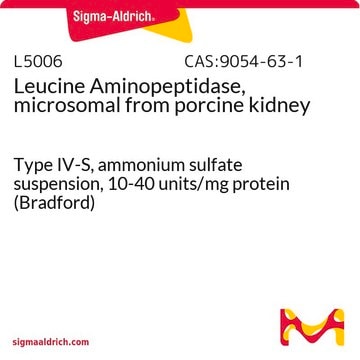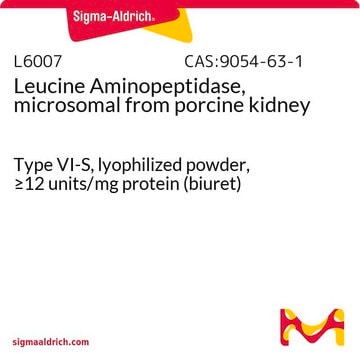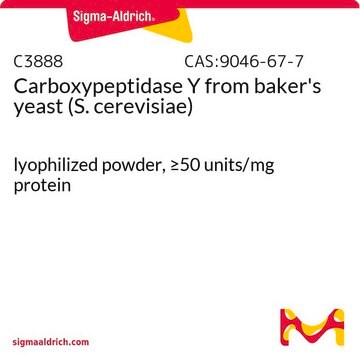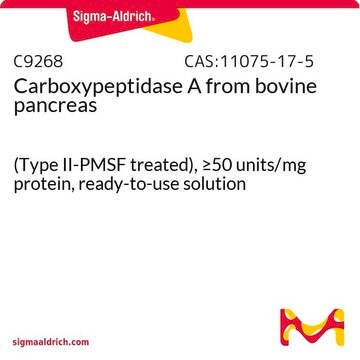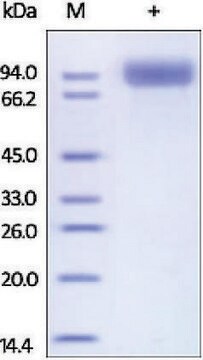164598
Aminopeptidase M, Porcine Kidney
Sinónimos:
Aminopeptidase M, Porcine Kidney, Alanyl aminopeptidase, Aminopeptidase M, Aminopeptidase N
Iniciar sesiónpara Ver la Fijación de precios por contrato y de la organización
About This Item
Número de CAS:
MDL number:
UNSPSC Code:
12352202
NACRES:
NA.54
Productos recomendados
General description
Aminopeptidase M (APM) is abundantly found in brush border membranes of the kidney, small intestine, placenta, and liver. It is a type II integral membrane protein, known as ectoenzyme.
Application
Aminopeptidase M, porcine kidney has been used:
- to test and identify the peaks containing d-residue in the allatotropin-related peptide (ATRP)
- to study its oxidative inactivation of enzyme activity, and to screen MIRA ingredients
- for the proteolysis of isolevuglandins (IsoLGs) proteins
Biochem/physiol Actions
Aminopeptidase M (APM) is implicated in terminating the actions of certain neuropeptides, like the enkephalins and angiotensin III in the brain. It also metabolizes specific vasoactive peptides. It functions as a receptor for certain viruses, such as coronavirus 229E. APM is a nonspecific peptidase, which rapidly breaks down l-residue peptides.
Packaging
Please refer to vial label for lot-specific concentration.
Warning
Toxicity: Harmful (C)
Unit Definition
One unit is defined as the amount of enzyme that will hydrolyze 1 µmol of Leu-pNA per min at 37°C, pH 7.2.
Physical form
Crystalline suspension in 3.2 M (NH₄)₂SO₄, 10 mM MgCl₂, 10 mM Tris-HCl, pH 7.5.
Other Notes
Wachsmuth, E.E., et al. 1966. Biochemistry5, 169.
Legal Information
CALBIOCHEM is a registered trademark of Merck KGaA, Darmstadt, Germany
Storage Class
12 - Non Combustible Liquids
wgk_germany
WGK 2
flash_point_f
Not applicable
flash_point_c
Not applicable
Certificados de análisis (COA)
Busque Certificados de análisis (COA) introduciendo el número de lote del producto. Los números de lote se encuentran en la etiqueta del producto después de las palabras «Lot» o «Batch»
¿Ya tiene este producto?
Encuentre la documentación para los productos que ha comprado recientemente en la Biblioteca de documentos.
Los clientes también vieron
Handbook of Proteolytic Enzymes (2012)
Oral Delivery of Peptide Formulations and Their Cellular Evaluation
Patil S, et al.
International Journal of Peptide Research and Therapeutics, 27(4), 2831-2844 (2021)
James W Checco et al.
The Journal of biological chemistry, 293(43), 16862-16873 (2018-09-09)
l- to d-residue isomerization is a post-translational modification (PTM) present in neuropeptides, peptide hormones, and peptide toxins from several animals. In most cases, the d-residue is critical for the biological function of the resulting d-amino acid-containing peptide (DAACP). Here, we
Valery N Yermalitsky et al.
Analytical biochemistry, 566, 89-101 (2018-11-21)
Isolevuglandins (IsoLGs) are a family of highly reactive 4-ketoaldehydes formed by lipid peroxidation that modify the lysyl residues of cellular proteins. Modification of proteins by IsoLGs have been shown to contribute to disease processes such as the development of hypertension.
Nuestro equipo de científicos tiene experiencia en todas las áreas de investigación: Ciencias de la vida, Ciencia de los materiales, Síntesis química, Cromatografía, Analítica y muchas otras.
Póngase en contacto con el Servicio técnico